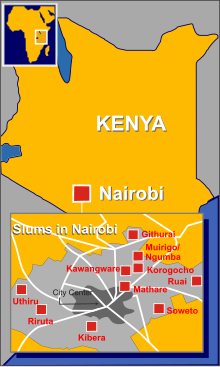
During the colonial occupation of Kenya, Black Africans working on farms owned by white settlers were called "squatters" by the British. As of 1945, there were over 200,000 such squatters in the Highlands and more than half were Kikuyu. The Mau Mau rebellion began amongst these squatters in the late 1940s and after independence in the early 1960s, peasants started squatting land in rural areas without the permission of the owner.
In recent years, community groups including indigenous peoples and squatters have challenged agricultural companies over land they regard as belonging to them following the foundation of the National Land Commission. In 2007, 55 per cent of Kenya's urban population lived in slums, in which people either owned, rented or squatted their houses and as of 2019, 4.39 million people lived in the capital Nairobi, with around half living in informal settlements such as Huruma, Kibera and Mathare.